John Hurrell – 5 August, 2013
Overall the uniting aural thread is a throbbing electronic pulse, layered with wobbly hums, buzzes and clicks, that marches along producing alternating coloured and b/w shapes on the walls. This flickering, stroboscopic flip-flop makes further strange effects such as mottled after-images, odd chromatic tinges on shape borders, or black bands that take on a slightly milky film - and white oblongs a misty shadow.
The current Clinton Watkins installation at Starkwhite uses some of the same ‘black box’ technology (called ‘AV5-Error’) he has used before - a process that uses analogue hardware to manipulate audio signals to construct visual video imagery. Sound here is used not only for its experiential aural qualities but also for the optical aspects Watkins is able to achieve through data ‘translation’. Eye and ear here are inseparable.
Four speakers and four projectors are used to create identical double images (butted together) on each of two long walls positioned opposite each other in the downstairs gallery. The loop is about 20 minutes long, the average time it takes to play the side of an LP.
Frequency Colour as a composition is made up of a sequence of joined up sections that feature different rhythmic pulses, colour ranges, aural frequencies, pixilated grid alignments, visual textures and directions of internally moving shapes. These sections are a bit like musical tracks on a record, each in isolation but still part of a greater contextual whole.
Overall the uniting aural thread is a throbbing electronic pulse, layered with wobbly hums, buzzes and clicks, that marches along producing alternating coloured and b/w shapes on the walls. This flickering, stroboscopic flip-flop makes further strange effects such as mottled after-images, odd chromatic tinges on shape borders, or black bands that take on a slightly milky film - and white oblongs a misty shadow. The sonic ‘background’ itself varies from a constant drone through regular beats and textures that hint at multiple triangles and tinkling bells, to something like rapid-fire improvised bass solos, while the flickering rectangular strips (usually horizontal) change their quality of edge so it can be sharp and constructivist - like say El Lissitsky - dragged and bristly as with Kline, or soft and stained (Rothko or Noland).
Watkins’ colour combinations also can be startlingly unpredictable, being often harsh red, blue or yellow blocks paired with black. These on the loop transmute through ochre landscape strata and clusters of delicate white lines - tilted on black, that look like intricately patterned Japanese fabrics - to sugary Nolandlike hues, pink horizontal bands on yellow fields. Sometimes the sizzling saturated colour pulls back to become a tertiary green or dull grey or brown, with the volume growing louder, more piercing and crackling in timbre - as if in compensation.
Obviously in the Starkwhite space, with a symmetrical image mirrored on each side, and loud penetrating sound out of every corner, this experience is highly immersive, though not overwhelmingly so. Reflected light bathes the ceiling, floor, columns and you, but you never feel bodily dissolved or disoriented by the chopping strobe. Nevertheless it is not for the fainthearted: to enjoy the full twenty-minute cycle you need a certain ‘clubbing’ stamina - and curiosity about what happens next.
John Hurrell
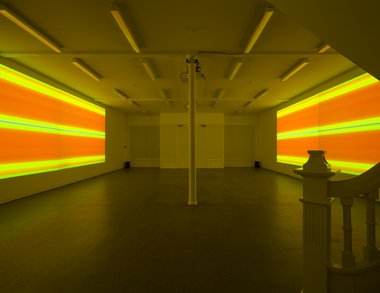
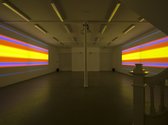
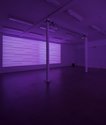
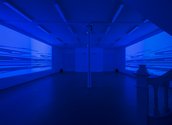
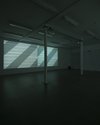
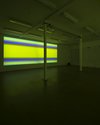
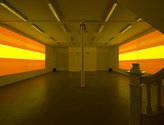
 Advertising in this column
Advertising in this column Two Rooms presents a program of residencies and projects
Two Rooms presents a program of residencies and projects



This Discussion has 1 comment.
Comment
Owen Pratt, 2:48 p.m. 5 August, 2013 #
Clint's work rocks; ups to the tolerance of the staff at Starkwhite.
Participate
Register to Participate.
Sign in
Sign in to an existing account.